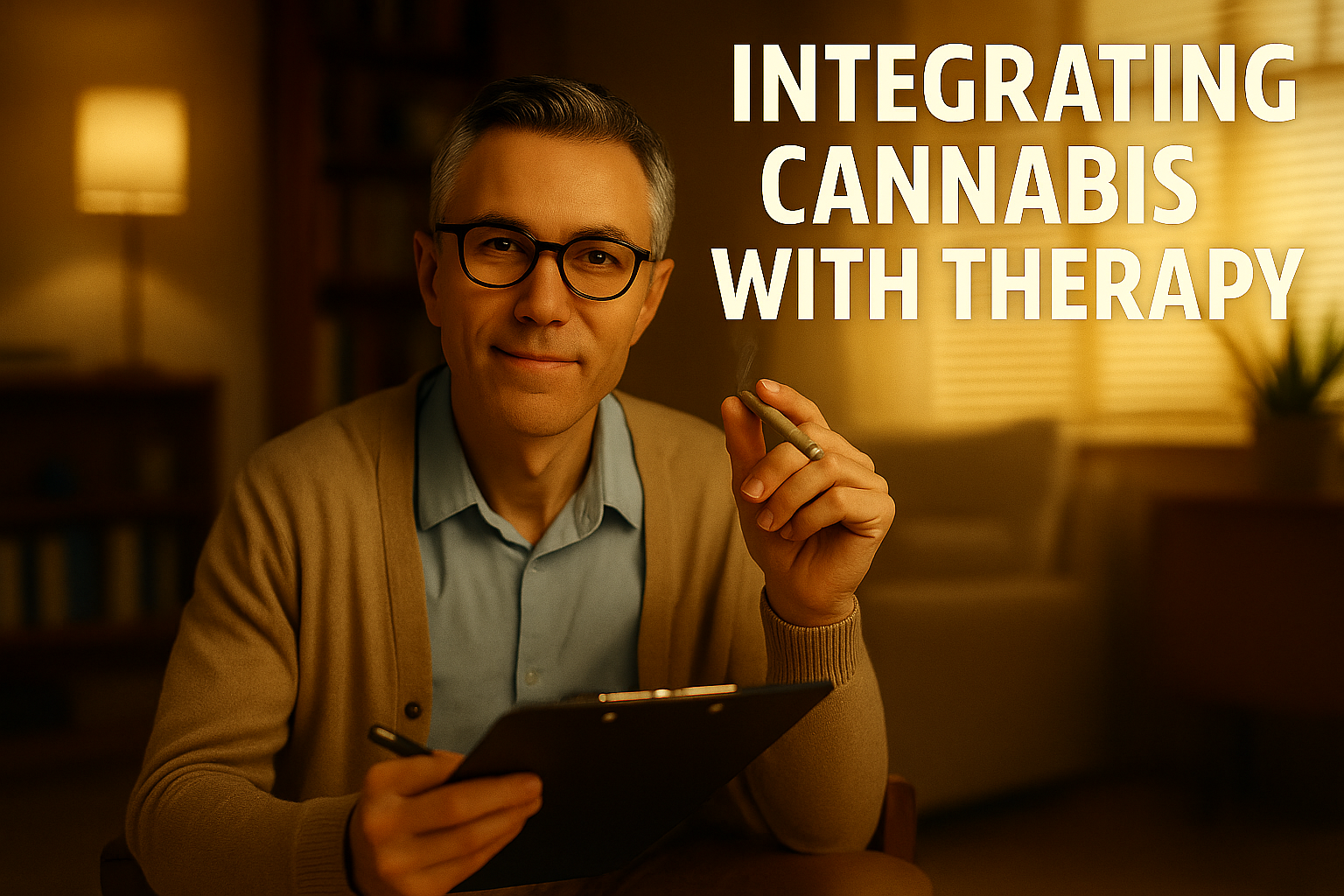
Integrating Cannabis With Therapy: A Comprehensive Guide to Enhanced Mental Health Treatment
The integration of cannabis with psychotherapy represents a growing frontier in mental health treatment, offering potential benefits for individuals seeking comprehensive approaches to wellness. As both cannabis acceptance and therapeutic innovation continue to evolve, understanding how to safely and effectively combine cannabis use with traditional therapy has become increasingly important for mental health consumers and practitioners alike. This guide explores the principles, practices, and considerations involved in integrating cannabis with various therapeutic modalities.
Understanding Cannabis-Therapy Integration
Cannabis-therapy integration involves the deliberate and informed combination of cannabis use with psychotherapeutic treatment to enhance mental health outcomes. This approach goes beyond simply tolerating cannabis use during therapy to actively considering how cannabis effects, timing, and therapeutic properties can complement and enhance traditional therapeutic interventions.
Successful integration requires understanding both cannabis pharmacology and therapeutic processes, recognizing how different cannabis compounds affect mood, cognition, and emotional processing. The goal is to optimize both cannabis use and therapy sessions to achieve better outcomes than either intervention might provide independently.
This integration model acknowledges that many individuals already use cannabis as part of their mental health self-care routine and seeks to harness this use therapeutically rather than requiring abstinence or ignoring cannabis effects on therapeutic progress. By working with rather than against cannabis use, integrated approaches can provide more personalized and effective mental health care.
The practice requires careful consideration of legal frameworks, ethical guidelines, and individual client needs. Integration strategies must account for varying state laws regarding cannabis use, professional licensing requirements, and the specific therapeutic goals of each client.
Scientific Foundation for Cannabis-Therapy Integration
Research into cannabis and mental health provides growing evidence for potential therapeutic benefits that can complement traditional psychotherapy. Studies have shown that cannabis compounds, particularly CBD and controlled amounts of THC, may help with anxiety reduction, trauma processing, and emotional regulation—all crucial elements in therapeutic work.
The endocannabinoid system plays a vital role in emotional processing, memory consolidation, and stress response—functions central to many therapeutic interventions. Cannabis compounds can influence this system in ways that may enhance the brain’s capacity for the neuroplasticity that underlies therapeutic change.
Neuroimaging studies suggest that cannabis use may affect brain regions involved in fear processing, emotional memory, and executive function. Understanding these effects helps therapists and clients optimize the timing and approach of cannabis use relative to therapeutic work.
Research on cannabis and PTSD has shown particular promise, with studies indicating that cannabis may help reduce nightmares, improve sleep, and decrease hypervigilance—symptoms that often interfere with trauma-focused therapy. This research provides a foundation for integrating cannabis with trauma therapy approaches.
Types of Therapy Compatible with Cannabis Integration
Different therapeutic modalities offer varying levels of compatibility with cannabis integration, depending on their focus, techniques, and theoretical framework. Understanding which approaches work best with cannabis integration helps both therapists and clients make informed decisions about combined treatment.
Cognitive Behavioral Therapy (CBT) can be effectively integrated with cannabis use when the focus is on developing coping strategies and changing thought patterns. Cannabis may help reduce anxiety that interferes with homework completion or skill practice, while CBT techniques can help optimize cannabis use patterns and develop healthy usage habits.
Trauma-focused therapies such as EMDR (Eye Movement Desensitization and Reprocessing) or Prolonged Exposure Therapy may benefit from cannabis integration for some clients. Cannabis may help manage overwhelming emotions during trauma processing, though careful timing and dosing are crucial to avoid interfering with memory processing mechanisms.
Mindfulness-Based Interventions often integrate naturally with cannabis use, particularly strains high in CBD or balanced THC/CBD ratios. Cannabis can enhance present-moment awareness and reduce mental chatter that interferes with mindfulness practice, while mindfulness techniques can enhance conscious cannabis use.
Psychodynamic therapy may benefit from cannabis integration when clients struggle with emotional access or defensiveness. Certain cannabis effects may lower psychological defenses and enhance emotional expression, facilitating deeper therapeutic exploration.
Dialectical Behavior Therapy (DBT) skills can be enhanced through mindful cannabis use, particularly techniques related to emotion regulation and distress tolerance. Cannabis may help some clients practice DBT skills more effectively while managing overwhelming emotional states.
Pre-Session Cannabis Use Considerations
The timing and approach to cannabis use before therapy sessions significantly impacts the integration process. Pre-session cannabis use requires careful planning to optimize therapeutic benefits while avoiding interference with cognitive function or emotional processing.
Microdosing approaches often work best for pre-session use, providing subtle effects that enhance relaxation and openness without impairing cognitive function. Small amounts of high-CBD strains may reduce session anxiety while maintaining mental clarity necessary for therapeutic work.
Timing considerations are crucial, as different consumption methods have varying onset times and duration of effects. Edibles may need to be consumed 1-2 hours before sessions, while vaping or smoking might be used 15-30 minutes beforehand for optimal timing of effects during therapy.
Individual tolerance and experience with cannabis greatly influence pre-session use strategies. New cannabis users or those with low tolerance should start with minimal amounts and work with their therapist to find optimal dosing that enhances rather than impairs therapeutic engagement.
Communication with therapists about pre-session use is essential for safety and effectiveness. Therapists need to understand client cannabis use patterns to adjust session approaches, recognize cannabis effects, and provide appropriate guidance for optimization.
Cannabis Use During Therapy Sessions
Some therapeutic approaches may incorporate cannabis use during actual therapy sessions, though this requires careful consideration of legal, ethical, and practical factors. In states where cannabis is legal and with appropriate professional guidelines, in-session use may be appropriate for certain clients and therapeutic goals.
Controlled cannabis use during sessions might involve microdosed edibles, low-dose vaping, or CBD-dominant preparations that provide therapeutic effects without significantly impairing cognition or judgment. The goal is to enhance therapeutic processes rather than create intoxication.
Safety protocols for in-session use include having a sober support person available, ensuring clients have safe transportation arrangements, and maintaining clear boundaries about dosing and consumption methods. Sessions involving cannabis use typically need extended time frames to account for onset, peak effects, and recovery periods.
Legal considerations vary significantly by state and locality, with some jurisdictions explicitly prohibiting cannabis use in healthcare settings while others may allow it under specific circumstances. Therapists considering in-session integration must thoroughly understand local laws and professional regulations.
Post-Session Integration Strategies
Cannabis use following therapy sessions can help with integration and processing of therapeutic material, particularly for clients who experience significant emotional activation during sessions. Post-session cannabis use requires different considerations than pre-session use, focusing on processing support rather than preparation.
Cannabis strains with balanced THC/CBD ratios or CBD-dominant varieties may help with emotional regulation following intense sessions while supporting the consolidation of therapeutic insights. The anti-anxiety properties of CBD can be particularly helpful for clients processing difficult material.
Timing of post-session use should allow for initial processing of session material while sober, followed by cannabis use to support continued integration and emotional regulation. Many clients benefit from a 30-60 minute gap between session end and cannabis consumption.
Integration activities might include journaling while using cannabis, engaging in creative expression, or practicing mindfulness techniques. These activities can help solidify therapeutic gains while utilizing cannabis effects to support emotional processing and insight development.
Dosing Strategies for Therapeutic Integration
Effective cannabis-therapy integration requires sophisticated understanding of dosing principles that differ from recreational use patterns. Therapeutic dosing focuses on achieving specific effects that support mental health goals rather than maximizing intoxication or euphoria.
Microdosing approaches often provide optimal results for therapy integration, using minimal effective doses to achieve therapeutic benefits while maintaining cognitive clarity and emotional accessibility. Typical microdoses range from 1-5mg of THC or equivalent amounts of other cannabinoids.
Individual dosing optimization requires systematic experimentation under professional guidance, starting with minimal doses and gradually adjusting based on therapeutic outcomes and side effects. Factors influencing optimal dosing include body weight, tolerance, consumption method, and specific therapeutic goals.
Strain selection plays a crucial role in therapeutic dosing, with different terpene profiles and cannabinoid ratios producing varied effects. Sativa-dominant strains might support morning therapy sessions focused on motivation and problem-solving, while indica-dominant varieties may be better suited for evening sessions involving relaxation and emotional processing.
Addressing Common Challenges and Concerns
Cannabis-therapy integration presents several challenges that must be addressed for successful implementation. Understanding and preparing for these challenges helps both therapists and clients navigate integration more effectively.
Cognitive impairment concerns are common, particularly around memory formation and recall of therapeutic material. Strategies to address these concerns include session recording (with consent), written summaries of key points, and follow-up communications to reinforce important insights.
Tolerance development can reduce therapeutic benefits over time, requiring periodic tolerance breaks or dosing adjustments. Working with knowledgeable professionals helps clients maintain therapeutic benefits while avoiding problematic use patterns.
Legal and employment concerns may limit integration options for some clients, particularly those in sensitive professions or states with restrictive cannabis laws. These factors must be carefully considered when developing integration strategies.
Therapeutic relationship boundaries require clear communication and professional guidelines when cannabis is involved in treatment. Both therapists and clients need explicit agreements about cannabis use expectations, safety protocols, and professional responsibilities.
Working with Cannabis-Informed Therapists
Successful cannabis-therapy integration requires working with mental health professionals who understand both cannabis effects and therapeutic processes. These therapists can provide guidance on optimal integration strategies while maintaining professional standards and client safety.
Cannabis-informed therapists should possess knowledge of cannabis pharmacology, dosing principles, strain differences, and consumption methods. They should be able to provide evidence-based guidance on how cannabis use might enhance or interfere with specific therapeutic interventions.
Communication with cannabis-informed therapists should include detailed discussions of cannabis use patterns, effects experienced, therapeutic goals, and any concerns about integration. Open dialogue helps optimize both cannabis use and therapeutic approaches for better outcomes.
Professional boundaries remain important even when therapists are cannabis-informed. These professionals provide guidance and support but typically cannot recommend specific cannabis products, dosing, or consumption methods due to legal and professional restrictions.
Legal and Ethical Considerations
Cannabis-therapy integration occurs within complex legal and ethical frameworks that vary significantly by location and professional context. Understanding these considerations is crucial for safe and effective integration practices.
State cannabis laws affect the availability and legality of different integration approaches, with medical marijuana states often providing more flexibility for therapeutic cannabis use than states with only recreational programs or prohibition.
Professional licensing boards have varying positions on cannabis and therapy integration, with some explicitly prohibiting therapist involvement in cannabis recommendations while others allow for general education and support within legal frameworks.
Informed consent processes for cannabis-therapy integration should include comprehensive discussions of potential benefits, risks, legal considerations, and alternative treatment options. Clients need complete information to make informed decisions about integration approaches.
Documentation considerations include maintaining appropriate records of cannabis-related discussions and interventions while protecting client privacy and complying with professional standards. Therapists must balance thorough documentation with discretionary record-keeping practices.
Measuring Integration Success
Successful cannabis-therapy integration requires systematic evaluation of outcomes to ensure that the combination is providing benefits beyond either intervention alone. Measurement approaches should assess both therapeutic progress and cannabis use outcomes.
Therapeutic progress indicators might include reduced symptom severity, improved coping skills, enhanced emotional regulation, better sleep quality, and increased engagement in therapy sessions. These outcomes should be tracked using standardized assessment tools when possible.
Cannabis use outcomes should be evaluated for optimization and safety, including assessment of dosing effectiveness, side effect management, tolerance development, and overall satisfaction with integration approaches. Regular review helps maintain therapeutic benefits while avoiding problematic use patterns.
Quality of life measures provide important indicators of integration success, including improvements in relationships, work performance, daily functioning, and overall life satisfaction. These broader measures help assess whether integration is supporting comprehensive wellness goals.
Long-term follow-up is essential for understanding the sustainability and ongoing benefits of cannabis-therapy integration. Regular check-ins help identify needs for adjustment, address emerging concerns, and maintain optimal integration strategies over time.
Special Populations and Integration Considerations
Different populations may have unique needs and considerations for cannabis-therapy integration, requiring specialized approaches and additional safeguards to ensure safe and effective treatment.
Veterans with PTSD may benefit significantly from cannabis-therapy integration, but require careful attention to potential interactions with VA healthcare, employment considerations, and trauma-specific treatment protocols. Integration approaches should account for military culture and specific veteran mental health needs.
Chronic pain patients often use cannabis for pain management while addressing mental health aspects of chronic illness. Integration strategies should coordinate with pain management approaches while addressing depression, anxiety, and adjustment challenges related to chronic conditions.
Adolescent and young adult populations require special consideration due to ongoing brain development, increased vulnerability to cannabis use disorders, and unique legal and ethical considerations. Integration approaches for younger populations should emphasize safety, monitoring, and conservative dosing strategies.
Older adults may have increased sensitivity to cannabis effects and potential interactions with other medications. Integration strategies should account for age-related changes in metabolism, multiple medication regimens, and specific mental health needs of older populations.
Future Directions and Emerging Research
The field of cannabis-therapy integration continues to evolve rapidly, with ongoing research providing new insights into optimal practices and potential applications. Staying informed about emerging developments helps both professionals and consumers make evidence-based decisions about integration approaches.
Psychedelic-assisted psychotherapy research is informing cannabis-therapy integration practices, particularly around preparation, session management, and integration of altered-state experiences. These approaches may offer models for optimizing cannabis-enhanced therapy sessions.
Precision medicine approaches to cannabis therapy are emerging, using genetic testing and biomarker analysis to optimize cannabis selection and dosing for individual clients. These personalized approaches may enhance integration effectiveness while reducing trial-and-error periods.
Technology integration including apps for tracking cannabis use and therapeutic outcomes, virtual reality therapy sessions enhanced with cannabis, and telemedicine approaches to integration support are expanding access to specialized integration services.
Conclusion
Integrating cannabis with therapy represents a promising frontier in personalized mental health treatment, offering potential benefits for individuals seeking comprehensive approaches to wellness. Successful integration requires careful consideration of dosing, timing, strain selection, legal factors, and therapeutic goals, all supported by knowledgeable professionals and evidence-based practices.
The key to effective cannabis-therapy integration lies in viewing cannabis as a tool that can enhance rather than replace traditional therapeutic interventions. When approached thoughtfully and systematically, integration can provide more personalized, effective, and satisfying mental health treatment experiences.
As research continues to expand our understanding of cannabis effects on mental health and therapeutic processes, integration practices will likely become more refined and widely available. For now, individuals interested in integration should work with cannabis-informed mental health professionals, stay informed about legal considerations, and prioritize safety and therapeutic goals in all integration decisions.
The future of mental health treatment may well include sophisticated integration of various therapeutic tools, including cannabis, to provide truly personalized and effective care that addresses the full spectrum of human wellness needs.





